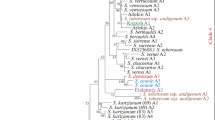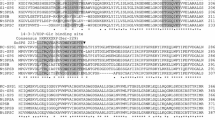Abstract
Group A Kunitz-type protease inhibitors (KPI-A) are involved in protecting potato plants from microorganisms and pests. While the nucleotide sequence is known for many KPI-A genes of various potato cultivars (Solanum tuberosum subsp. tuberosum) and a few genes of tomato (Solanum lycopersicum), there are no data on their allelic diversity in other species of the genus Solanum. KPI-A fragments were cloned, amplified, sequenced, and analyzed from plants of the subgenera Potatoe sect. Petota (five genes from S. tuberosum ssp. andigenum and two genes from S. stoloniferum) and Solanum (five genes from S. nugrum), and their consensus sequences were established. An identity of 97–100% was observed among these sequences and the KPI-A sequences of the sections Petota (cultivated potato Solanum tuberosum ssp. tuberosum) and Etuberosum (S. palustre) The interspecific variation of KPI-A did not exceed its intraspecific variation for all but one species (S. lycopersicum). The distribution of highly variable and conserved sequences in the mature protein-coding region was the same in all of the above species. The same primers failed to amplify the homologous genes from Solanum dulcamara, S. lycopersicum, and Mandragora officinarum. Phylogenetic analysis of the KPI-A sequences showed that S. lycopersicum clustered separately from all of the other species examined, that S. nigrum clustered together with species of the sections Etuberosum and Petota, and that these species produced no species-specific clusters. Although S. nigrum is resistant to all known races of the oomycete Phytophthora infestans, which causes one of the most economically important diseases of Solanaceae, the amino acid sequences encoded by S. nigrum KPI-A differed slightly, if at all, from their counterparts of cultivated potato, which is susceptible to P. infestans infection.
Similar content being viewed by others
References
Ishikawa A., Ohta S., Matsuoka K., Hattori T., Nakamura K. 1994. A family of potato genes that encode Kunitz-type proteinase inhibitors: structural comparisons and differential expression. Plant Cell Physiol. 35, 303–312.
Heibges A., Glaczinski H., Ballvora A., Salamini F., Gebhardt C. 2003. Structural diversity and organization of three gene families for Kunitz-type enzyme inhibitors from potato tubers (Solanum tuberosum L.). Mol. Genet. Genomics. 269, 526–534.
Bauw G., Nielsen H.V., Emmersen J., Nielsen K.L., Jorgensen M., Welinder K.G. 2006. Patatins, Kunitz protease inhibitors and other major proteins in tuber of potato cv. Kuras. FEBS J. 273, 3569–3584.
Gruden K., Strukelj B., Ravnikar M., Poljsak-Prijatelj M., Mavrie I., Brzin J., Pundecar J., Kregar I. 1997. Potato cysteine proteinase inhibitor gene family: molecular cloning, characterisation and immunocytochemical localisation studies. Plant Mol. Biol. 34, 317–323.
Stiekema W.J., Heidekamp F., Dirkse W.G., Van Beckum J., Haan P., ten Bosch C., Louwerse J.D. 1988. Molecular cloning and analysis of four potato tuber mRNAs. Plant Mol. Biol. 11, 255–269.
Strukelj B., Pungercar J., Ritonja A., Krizaj I., Gubensek F., Kregar I., Turk V. 1990. Nucleotide and deduced amino acid sequence of an aspartic proteinase inhibitor homologue from potato tubers (Solanum tuberosum L.). Nucleic Acids Res. 18, 4605.
Hannapel D.J. 1993. Nucleotide and deduced amino acid sequence of the 22-kilodalton cathepsin D inhibitor protein of potato (Solanum tuberosum L.). Plant Physiol. 101. 703-704.
Herbers K., Prat S., Willmitzer L. 1994. Cloning and characterization of a cathepsin D inhibitor gene from Solanum tuberosum L. Plant Mol. Biol. 26, 73–83.
Odeny D.A., Stich B., Gebhardt C. 2010. Physical organization of mixed protease inhibitor gene clusters, coordinated expression and association with resistance to late blight at the StKI locus on potato chromosome III. Plant Cell Environ. 33, 2149–2161.
The Potato Genome Sequencing Consortium. 2011. Genome sequence and analysis of the tuber crop potato. Nature. 475, 189–195.
Mares M., Meloun B., Pavlik M., Kostka V., Baudys M. 1989. Primary structure of cathepsin D inhibitor from potatoes and its structure relationship to soybean trypsin inhibitor family. FEBS Lett. 251, 94–98.
Heibges A., Salamini F., Gebhardt C. 2003. Functional comparison of homologous members of three groups of Kunitz-type enzyme inhibitors from potato tubers (Solanum tuberosum L.). Mol. Genet. Genomics. 269, 535–541.
Lison P., Rodrigo I., Conejero V. 2006. A novel function for the cathepsin D inhibitor in tomato. Plant Physiol. 142, 1329–1339.
Ritonja A., Krizaj I., Mesko P., Kopitar M., Lucovnik P., Strukelj B., Pungercar J., Buttle D.J., Barrett A.J., Turk V. 1990. The amino acid sequence of a novel inhibitor of cathepsin D from potato. FEBS Lett. 267, 13–15.
Strukelj B., Pungercar J., Mesko P., Barlic-Maganja D., Gubensek F., Kregar I., Turk V. 1992. Characterization of aspartic proteinase inhibitors from potato at the gene, cDNA and protein levels. Biol. Chem. Hoppe Seyler. 373, 477–482.
Suh S.G., Peterson J.E., Stiekema W.J., Hannapel D.J. 1990. Purification and characterization of the 22-kilodalton potato tuber proteins. Plant Physiol. 94, 40–45.
Werner R., Guitton M.C., Muhlbach H.P. 1993. Nucleotide sequence of a cathepsin D inhibitor protein from tomato. Plant Physiol. 103, 1473.
Brenner E.D., Lambert K.N., Kaloshian I., Willamson V.M. 1998. Characterization of LeMir, a root-knot nematode-induced gene in tomato with an encoded product secreted from the root. Plant Physiol. 118, 237–247.
Aoki K., Yano K., Suzuki A., et al. 2010. Large-scale analysis of full-length cDNAs from the tomato (Solanum lycopersicum) cultivar Micro-Tom, a reference system for the Solanaceae genomics. BMC Genomics. 11, 210.
Hildmann T., Ebneth M., Peña-Cortes H., Sanchez-Serrano J.J., Willmitzer L., Prat S. 1992. General roles of abscisic and jasmonic acids in gene activation as a result of mechanical wounding. Plant Cell. 4, 1157–1170.
Kreft S., Ravnikar M., Mesko P., Pungercar J., Umek A., Kregar I., Strukelj B. 1997. Jasmonic acid inducible aspartic proteinase inhibitors from potato. Phytochemistry. 44, 1001–1006.
Barone A., Chiusano M.L., Ercolano M.R., Giuliano G., Grandillo S., Frusciante L. 2008. Structural and functional genomics of tomato. Int. J. Plant Genomics. 2008, 820274.
Poczai P., Hyvonen J. 2011. On the origin of Solanum nigrum: can networks help? Mol. Biol. Rep. 38, 1171–1185.
Edwards K., Johnstone C., Thompson C. 1991. A simple and rapid method for the preparation of plant genomic DNA for PCR analysis. Nucleic Acids Res. 19, 1349.
Peralta I.E., Spooner D.M. 2000. Classification of wild tomatoes: A review. Tomo. 28, 45–54.
Jacobs M.M., van den Berg R.G., Vleeshouwers V.G., Visser M., Mank R., Sengers M., Hoekstra R., Vosman B. 2008. AFLP analysis reveals a lack of phylogenetic structure within Solanum section Petota. BMC Evol. Biol. 8, 145.
Poczai P., Taller J., Szabo I. 2008. Analysis of phylogenetic relationships in the genus Solanum (Solanaceae) as revealed by RAPD markers. Plant Syst. Evol. 275, 59–67.
Spooner D.M., Anderson G.J., Jansen R.K. 1993. Chloroplast DNA evidence for the interrelationships of tomatoes, potatoes, and pepinos (Solanaceae). Am. J. Bot. 80, 676–688.
Bohs L., Olmstead R.G. 1997. Phylogenetic relationships in Solanum (Solanaceae) based on ndhF sequences. Syst. Bot. 22, 5–17.
Olmstead R.G., Sweere J. A., Spangler R.E., Bohs L., Palmer J.D. 1999. Phylogeny and provisional classification of the Solanaceae based on chloroplast DNA. In: Solanaceae IV. Eds Nee M., Symon D.E., Lester R.N., Jessop J.P. Kew: Royal Botanical Gardens, pp. 111-137.
Peralta I.E., Spooner D.M. 2001. Granule-bound starch synthase (GBSSI) gene phylogeny of wild tomatoes (Solanum L. section Lycopersicon [Mill.] Wettst. subsection Lycopersicon). Am. J. Bot. 88, 1888–1902.
Marshall J.A., Knapp S., Davey M.R., Power J.B., Cocking E.C., Bennett M.D., Cox A.V. 2001. Molecular systematics of Solanum section Lycopersicum (Lycopersicon) using the nuclear ITS rDNA region. Theor. Appl. Genet. 103, 1216–1222.
Spooner D.M., Peralta I., Knapp S. 2005. Comparison of AFLPs with other markers from phylogenetic inference in wild tomatoes (Solanum L. section Lycopersicon (Mill.) Wettst.). Taxon. 54, 43–61.
Darwin S.C., Knapp S., Peralta I.E. 2003. Taxonomy of tomatoes in the Galapagos Islands: native and introduced species of Solanum section Lycopersicon (Solanaceae). Syst. Biodivers. 1, 29–53.
Rodriguez F., Wu F., Ane C., Tanksley S., Spooner D.M. 2009. Do potatoes and tomatoes have a single evolutionary history, and what proportion of the genome supports this history? BMC Evol Biol. 9, 191.
Author information
Authors and Affiliations
Corresponding author
Additional information
Original Russian Text © A.A. Krinitsina, N.V. Melnikova, M.S. Belenikin, P. Poltronieri, A. Santino, A.V. Kudryavtseva, A.M. Savilova, A.S. Speranskaya, 2013, published in Molekulyarnaya Biologiya, 2013, Vol. 47, No. 3, pp. 405–412.
Rights and permissions
About this article
Cite this article
Krinitsina, A.A., Melnikova, N.V., Belenikin, M.S. et al. Polymorphism of the KPI-A gene sequence in the potato subgenera Potatoe (Sect. Petota, Esolonifera, and Lycopersicum) and Solanum . Mol Biol 47, 358–363 (2013). https://doi.org/10.1134/S0026893313030059
Received:
Accepted:
Published:
Issue Date:
DOI: https://doi.org/10.1134/S0026893313030059




